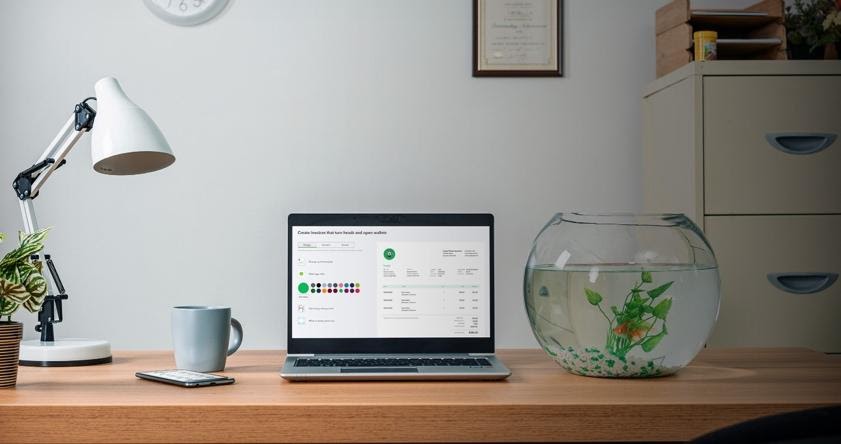E-invoicing explained for bookkeepers
TechnologyIntuit QuickBooks recently held an e-invoicing webinar with industry experts from the ATO, ASBFEO & the Australian Bookkeeper Network. Learn how the adoption of e-invoicing can help your clients get paid faster.

The Australian government is leading a push to accelerate the adoption of e-invoicing, recently announcing more funding for e-invoicing to help businesses reduce costs and lift productivity1. The adoption of e-invoicing has great potential to simplify processes and help your small business customers get paid faster.
Learn what these changes mean for bookkeepers and the systems that will support them.
What is e-invoicing?
Electronic invoicing (e-invoicing) is the ability to send invoices directly from one organisation’s financial systems to another. It’s the quickest and most cost-effective way to ensure that invoices are approved, processed, and paid. It does not involve emailing invoices, nor is it a PDF invoice, rather it is a software-generated invoice.
It’s a practice that has been used for decades. Some larger companies established data links for the transfer of documents including invoices and purchase orders as far back as the 1960s, but these custom-built systems were never designed to be scalable. It became standardised through enterprise resource planning systems in the 1990s, but this functionality was still reserved for the top end of town.
Rapid growth in e-commerce and other digital business processes in recent years has been accelerated by the COVID-19 pandemic and the federal government is also updating public policy to reflect this.
A big piece of news for bookkeepers and their clients is $15.3 million set aside to encourage businesses to use e-invoicing. This is very welcome and will assist small businesses to better manage their cash flow.
The federal government has adopted the Pan-European Public Procurement Online (PEPPOL) standard for e-invoicing2. This standard enables organisations to exchange documents such as invoices and remittances between their respective finance systems, regardless of the software they use to create those documents.
PEPPOL is used in more than 30 countries including England, France, Germany, New Zealand and Singapore. It identifies an invoice recipient using their Australian Business Number (ABN). With more than 1.2 billion invoices sent around Australia every year. Deloitte Access Economics estimates3 e-invoicing has the potential to deliver $28 billion in savings to our national economy over 10 years.
What are the benefits?
Processing invoices manually is expensive. The Australian Taxation Office (ATO) estimates it costs more than $30 on average to process a paper invoice and almost $28 for an emailed PDF version4. Not having to handle each invoice means that the cost of processing an e-invoice is less than $10. This makes it up to three times more cost-effective, with those savings shared between buyers and sellers.
Manual processes can also introduce hidden costs like late fees and missed discounts for early payment. These financial penalties chip away at hard-earned small business profits, but e-invoicing helps to avoid them by enabling better planning.
E-invoicing also significantly reduces the risk of paying fraudulent invoices, because all businesses using the PEPPOL network are registered and identified using their Australian Business Number (ABN). The Australian Competition and Consumer Commission estimates that fraudulent invoices cost businesses $132 million in 20195.
There are also significant benefits associated with the removal of time and cost inefficiencies. Making the switch to e-invoicing removes the need to rekey or scan invoices into financial systems, make corrections or chase missing information. Working to a common standard will ensure data is entered correctly before an invoice is sent.
From a small business advisor’s perspective, the biggest benefit is heling their small business clients to get paid faster. Technology has done so much to improve business processes, but the cash flow issues created by payment delays continue to be a big issue for small business owners. Having an invoice sent straight from one financial system to another removes the opportunity for it to get lost in the post, overlooked or simply ignored in somebody’s inbox.
It’s also the most environmentally friendly option because e-invoicing moves small businesses – as well as the many large companies and government departments they serve – one step closer to paperless operations. Eliminating transport and electronic processing costs means using less energy.
E-invoicing also presents many small businesses with significant new opportunities that you can help them explore, because they can more easily supply larger organisations.
With e-invoicing, they are also able to more easily buy or sell across international borders, most notably into New Zealand through the Trans-Tasman Electronic Invoicing Arrangement, which has seen both nations agree to common approaches toward this important technology. Australia also has an agreement to work with Singapore on e-invoicing and will be able to work with other countries using PEPPOL in the future.
Why is it happening?
Technology has improved so many processes in recent decades, but cash flow is still one of the most significant pain points for small businesses and their bookkeepers. A lot of this comes down to efficiency and reliability because people will often miss an email or forget to action it. There are just so many points of potential failure in the chain between generating an invoice and receiving payment.
There have also been issues with larger organisations implementing longer payment terms and waiting until the last possible moment to settle invoices. ASBFEO research estimates more than half of invoices are paid late (53 per cent) and are 23 days overdue on average. These overdue invoices are worth $115 billion, or $52,000 for every small business in Australia6.
Where to from here?
The Australian government has committed to processing 80 per cent of invoices electronically by the end of this financial year, and all invoices by June 20227. It is also consulting with large enterprises and small business on broader adoption of this technology.
Telcos and utilities will play a key role in meeting this target, given they touch such a high percentage of businesses. Bookkeepers also have a crucial role to play as the trusted financial advisers of small business owners.
Consultation on potential mandatory and non-mandatory adoption options is also underway, with the Treasury flagging three potential outcomes: a mandatory adoption requirement for all businesses phased in over time; a mandate for large businesses only; and a flexible non-regulatory approach so businesses can choose when the adopt e-invoicing8.
Moving to e-invoicing is part of a wider shift to digital services that will improve productivity, freeing up time for more valuable work. It will help business owners and bookkeepers to improve record keeping, track bad debtors, meet reporting obligations, and increase cash flow.
The first step is to ensure clients adopt systems with a clear commitment to e-invoicing. Then they need to validate business customer ABNs, making sure this data is entered into systems so that they can send e-invoices. Remind clients that supply government to ask their contract managers if they support e-invoicing yet.
The most significant early adoption could well be seen within local councils, because they typically have higher levels of exposure to small businesses. But regardless of which organisations your small business clients supply, e-invoicing will play an important role in making sure they get paid on time in the future.
What is QuickBooks doing to support e-invoicing?
Intuit QuickBooks supports sending and receiving e-invoices by giving bookkeepers a choice of app store partners to connect to the PEPPOL e-invoicing network. We also participated in an e-invoice pilot facilitated by the ATO, which showed how easy it is to start e-invoicing.
You can learn more about how Intuit QuickBooks can help you support your clients in the rollout of e-invoicing through the adoption of cloud accounting software here.
Footnotes
1Budget 2021–22 Fact Sheets, https://digitaleconomy.pmc.gov.au/fact-sheets/sme-digitalisation, accessed 12/05/21
2Options for mandatory e-Invoicing adoption by businesses, https://treasury.gov.au/consultation/c2020-122716, accessed 12/05/21
3Introduction of electronic invoicing (e-invoicing) into the Australian market, 2021, https://www2.deloitte.com/content/dam/Deloitte/au/Documents/tax/deloitte-au-tax-insights-5-e-invoicing-310321.pdf, accessed 12/05/21
4Op. cit
5Scams cost Australians over $630 million, ACCC, 2020, https://www.accc.gov.au/media-release/scams-cost-australians-over-630-million, accessed 12/05/21
6Legislation may be the only way to fix payment times: Ombudsman, ASBFEO, 2020, https://www.asbfeo.gov.au/news/news-articles/legislation-may-be-only-way-fix-payment-times-ombudsman, accessed 12/05/21
7E-invoicing, ATO, https://www.ato.gov.au/business/e-invoicing/, accessed 12/05/21
8Op. cit





You are not authorised to post comments.
Comments will undergo moderation before they get published.